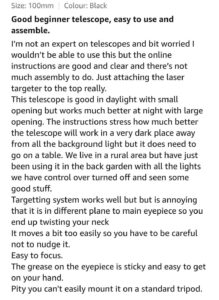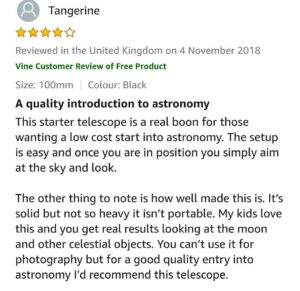*This post may contain affiliate links. This means we may make a commission if you purchase an item using one of our links*
Welcome to my Zhumell Z100 Review!
In this review I’ll cover the pros, cons and the Zhumell Z100’s features to ultimately help you decide on whether the Zhumell Z100 is a beginner level system worth investing in or one that you should skip.
Overview
Table of Contents
- Full Name: Zhumell Z100
- Type: Reflector
- Aperture: 4″(100mm)
- Focal length: 400mm
- Focal ratio: f/4
- Dimensions & Weight:
- Included eyepieces: two 1.25″ kellner eyepieces at 17mm and 10mm
- Rating: 4.8/5
Pros
- Easy to use
- Pre-assembled out of the box
- Good accessories
- Great value for money
- Compact and portable
Cons
- Will need regular maintenance and collimation
- Not very usable at its max power
- Industry standard 1.25” focuser, compatible with many different accessories
- Changing magnifications is easier than ever with included 17mm and 10mm eyepieces
- Easy to use red dot finder makes aiming the Z100 a breeze for any level of user
How Do The Zhumell Z100’s Optics Work?
The Zhumell Z100 is the entry level system within the Zhumell Z line up and much like the Z114 and the Z130, the Z100 also uses reflector optics within the its tube. If don’t already know, reflector optics are one of 3 different variations found within telescopes, with compound and refractor optics being the other two.
All of them have their pros and cons but, in this section I’ll only be going over the main pros and cons of the reflector optics (if you want to learn a bit the other 2 variations, click here to check out this article we wrote in the topic).
The pros of the reflector optics found within the Zhumell Z100 include :
- Good for viewing faint objects in outer space
- No chromatic aberration
- Cheaper to manufacture
The cons of the reflector optics found within the Zhumell Z100 include :
- Open optics means regular maintenance is required
- Coma is prevalent on lower focal ratio systems
- They need to be collimated very regularly too
These won’t be completely detrimental to your experiences with the Zhumell Z100 but, it’s definitely worth knowing them if you were to purchase the device. In fact most of the cons are more so minor annoyances that over time will become very easy to manage so I personally can’t say the reflector optics found in the device have any huge cons.
What Do The Zhumell Z100’s Specifications Mean?
The Zhumell Z100’s specs are pretty modest considering it’s around $100 but they’re not too bad for a cheaper telescope either. The Zhumell Z100 has an aperture of 100mm, a focal length of 400mm resulting in a very fast and wide focal ratio of f/4.
What these specs means is that theoretically you’ll be able to use the telescope at a 200x magnification however, in reality due to a few real world issues such as a somewhat wobbly image at that magnification, the real useful magnification will be a little lower.
Also the f/4 focal ratio does mean coma will be a lot more prevalent on the edges of the view you’ll see through the viewfinder.
Even with these very low /beginner level specs for a telescope, provided you find yourself in the right environment and are able to either achieve the Z100’s maximum power through the use of good quality eyepiece, you will be able to see quite a. few celestial objects :
- The moon and some details of the craters across its surface.
- Jupiter, Venus, Saturn and Mars should look pretty great through the scope and fairly easy to locate.
- Uranus and Neptune will also be viewable although only at around max power and only as blue disc like objects.
- Galaxies, nebulaes, star clusters and large parts of the messier catalogue should be viewable too although, as mentioned the coma the Z100 suffers with will elongate some stars, making them less accurate through the lens.
Of course because of its lower specifications, it also means the weight of the device is smaller, where in this case the tabletop design limits the dimensions to 36.8 x 27.9 x 29.8 cm by 2.38 kg respectively. I’m sure you’ll agree with me on saying that no one, including children, will have any problems moving the Z100 around.
Accessories Included In The Box?
The accessories you’ll find in the box include a 1.25″ focuser, a red dot pointer, two kellner 1.25″ eyepieces at 17mm (24x)and 10mm (40x) and a bunch of other miscellaneous documents.
The eyepieces are alright and will work just fine when starting out but they do have a very short eye relief and aren’t the most comfortable of accessories to use due to the lack of any rubber coating on the ends of each one of the eyepieces.
You will definitely need to upgrade to better quality eyepieces down the line (check out this article we wrote on some good eyepieces to look into by clicking here) but, for the price you’re paying for the whole system, the cheaper kellner aren’t too shabby either.
As for the other accessories, the red dot finder and the focuser are good too and won’t cause very many issues.
==>Click Here To Check The Zhumell Z100’s Pricing On Amazon!
The Mount
As for the mount, you’d be pleased to know that it essentially comes pre-assembled out of the box so you won’t need to fiddle around with it too much and it’s also a tabletop mount meaning you’ll need to place it at a comfortable height to get solid views.
It’s a dobsonian tabletop that attaches via a plastic vixen dovetail saddle design. The mount is mostly constructed of particle board whilst the azimuth bearings are made from real Teflon pad, which is quite surprising considering the systems price.
There’s also a hole underneath the board where you can attach the mount to a tripod however, from what I’ve researched, it probably won’t provide the most stable of experiences.
In fact, in general because of the lack of stability when it comes to the mount, being able to utilise an eyepiece that’s narrow and above 150x will be very difficult to do unless you invest in a mount that’s also a bit heavier allowing for more stability.
What Are Users Of The Zhumell Z100 Saying
Pretty much everyone who has ordered the Zhumell Z100 and understood that the system was a beginner level system, were very impressed with it, from the quality of the image to the easy to follow instructions and easy setting up process.



All in all the system appears to be a very solid beginner level telescope at the $100 range and most found it to be just an excellent bit of kit for the price and ultimately for the value it provides.
Other Alternatives Worth Checking Out
As a $100 telescope, there literally is nothing in the market that beats it however, if you’re willing to spend a bit more, getting the Zhumell Z114, Z130 or even the Z8 are worth looking into.
On the other hand the Z100 isn’t the greatest of systems for viewing planets or even a very competent astrophotography system so, if those 2 factors are important to you, you can either click here for an article written on the best astrophotography telescopes or click here to check out our list on the best telescopes for viewing planets
Summary
All in all the Zhumell Z100 is very good device and value for money coming with a great set of accessories for the price, being extremely affordable, easy to use, easy to set up and ultimately a great place to start for a beginner.
Of course the fact you need to regularly maintain and collimate it might come across as a minor annoyances but, once again for the price, the Zhumell Z100 is one of the best systems in its class.
==>Click Here To Check The Zhumell Z100’s Pricing On Amazon!
There are affiliate links on this article *



My Zhumell 100 had a loose wobbly plastic focuser I had to shim and eventually drill and tap a hole on the side to hold the focuser tube from moving sideways. You can only adjust the collimation from the secondary and my collimation was a doggone joke. I now despise Celestron’s YouTube lackey who said it was a great scope as I thought he was honest and I bought this piece of junk based on his video review. Celestron now owns Zhumell is what they told me when I called requesting missing parts.
I’ve had the Z100 for approximately 6 months and think it’s a beautiful little scope.
I live in a heavily light-polluted area and am disabled so I’m limited as to how I can view the sky. Knowing this, it was pointless spending lots on a bigger scope.
I usually view through my bedroom window for Eastward observation or take my scope into my westward-facing balcony.
I’ve got some Amazon basics shelving which serves its purpose perfectly too.
The only thing that needed attention was the focusser which was slightly stiff but a drop of oil corrected that.
I’ve now got a full range of lenses, including a 2x Barlow and a zoom so I can observe just about anything that the sky permits.
I’ve also bought a phone adaptor so I can record my observations on my blog.
I’m quite happy looking at the brighter objects and am fully aware of the limitations of my scope and my circumstances. Bearing this in mind, I heartily recommend this lovely device to anyone.